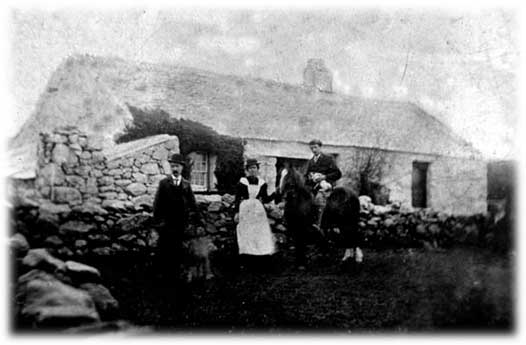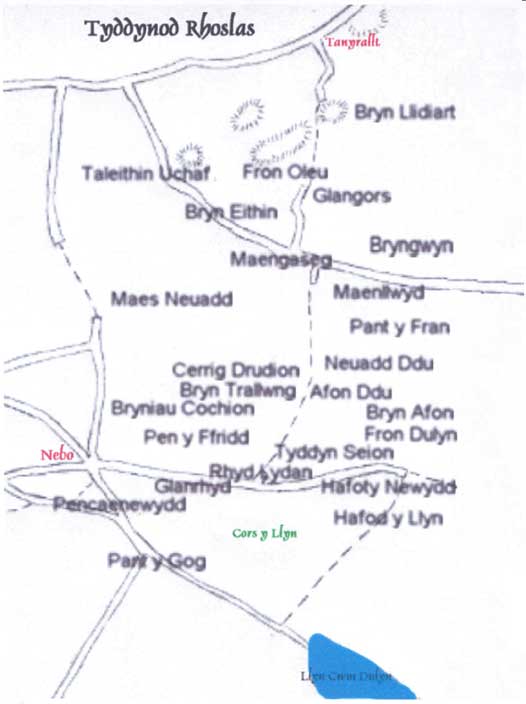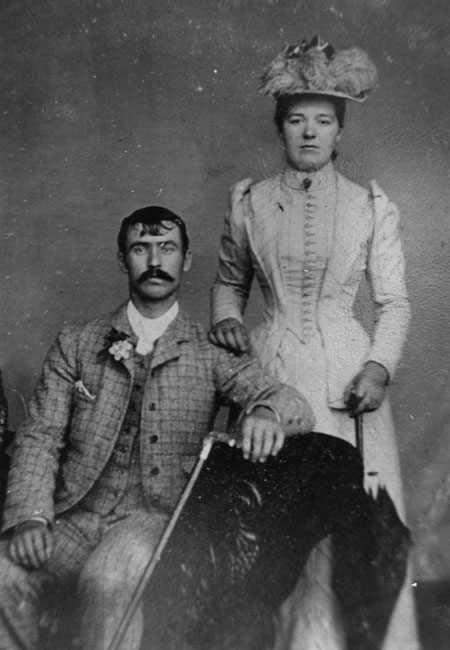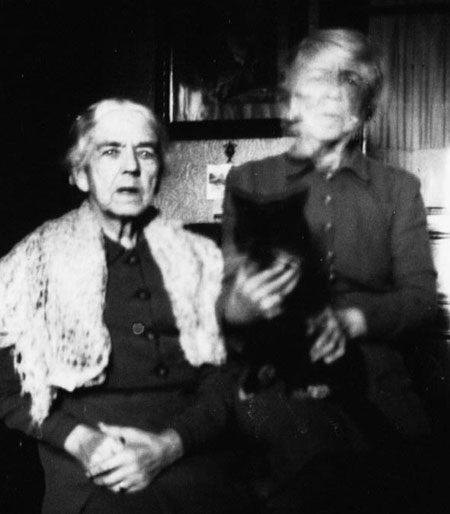The
Smallholdings of Rhoslas, Nebo

Image: William
Pritchard and wife Rachel Jones standing outside
Neuadd ddu cottage.
During the 19th century, small farms were established on
Rhoslas, chiefly because of the development of the
quarries in Dyffryn Nantlle. Compared to the
slate village Llanllyfni with it's ribbon development
of terraces along the road, it is obvious
how different Rhoslas is. The men would cheifly work
in the quarries, but they had the opportunity to
keep livestock and grow crops which gave them a better
standard of living than those who lived in houses
without land. It was a scattered community, of a
type very common in Wales. In Scotland they are called
'Townships', that is to say: not nuclear villages.
A valuable description of the crofter's life is to
be found in Atgofion
Mab y Mynydd, by Mathonwy Huws (Gwasg Gee 1982). He was born in Bryn Llidiart, Rhoslas. One may also see documents in the Archives, Caernarfon by W R Williams, Harri
Wyn Williams and others. A series of their articles
were published in the local Welsh language newspaper,
Lleu, during 1986-1987 and 1990- 1991. These
may be seen in the Public Library, Penygroes.
Dr R Alun
Roberts, scientist, naturalist and broadcaster
was born in Glan y Gors, Rhoslas. His recollections
are to be found in Hafodydd Brithion and in Darlith
Flynyddol Llyfrgell Penygroes 1968 (The Annual
Library lecture 1968 - a very rare booklet). His
history of agriculture in this area is given in
English in the wholly inappropriately named Welsh
Home Spun (1930).
The works of Kate Roberts, who was brought up in a
very similar area in Rhosgadfan, should be read.
Many are now available in English and other languages.
Concerned over the health of the nation, powers were given
to the County Councils by Parliament to improve
the people's health. It is said that the highest
incidence of tuberculosis in Wales was in Nebo.
Although the condition of the houses did not in
themselves cause T.B., damp was no good for anyone,
and if too many people lived in the same house,
then certainly the disease would spread quickly.
The Campaign to Overcome Tuberculosis began in 1910
and one of it's chief supporters was the teacher
and minister Silyn Roberts
1871-1930. (He was also born in Bryn Llidiart,
Rhoslas - an uncle to Mathonwy Huws). T.B. was
not completely controlled until the discovery of
X-rays and anti-biotics.
Local authorities were allowed to build council houses
with all the necessary amenities. A substantial
number of crofters, some with large families, were
more than content with such an offer. Council houses
were built in Nebo in 1933 and 1951.
Most of the quarries were closed before the Second World
War 1939.-1945. If an unemployed person had a patch
of land, a cow, a pig or sheep, it would be impossible
to claim the dole, even if their income was very
small - a great number moved from the land because
of these severe rules. Because there were
so few jobs available in the county, many went
to the South (Wales), to England and some even
went overseas. A whole community was dispersed
- most of the houses lay empty. The stone
walls collapsed - there was no need for the farmers
to repair them, and their flocks roamed across
the land.
During the 20th century, some of the houses (usually without
their land) were sold for a few hundred pounds,
chiefly to new-comers or as weekend cottages. About
half of the old cottages of Rhoslas (11 in all)
remain as ruins.

Past inhabitants of Neuadd Ddu

Image: William
Pritchard and Rachel Jones' wedding photograph.

Image: Rachel
Pritchard and her sister Jane Jones, 1946.
Thanks to Barbara Seaton for the photographs |